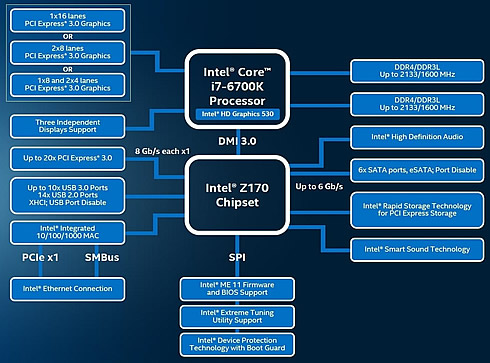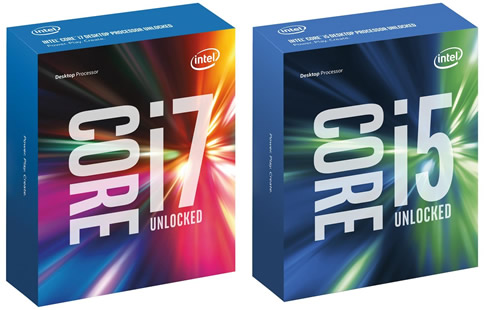
Intel Teases With Skylake Processor Family and Z170 Express Chipset Debut
Intel has announced its first 6th generation Core processors codenamed "Skylake" along with the Z170 Express chipset at Gamescom, but detailed information will not be available before the end of this month. The new processors are built on Intel's new 14 nanometer silicon fab process. They come in a new LGA1151 package, support DDR4 memory and promise to offer IPC improvements over the "Haswell" and "Broadwell" processors.
At Gamescom, Intel showcases two chips targeted at the DIY gaming PC crowd - the Core i7-6700K and the Core i5-6600K quad-core processors. The company also announced the Z170 Express chipset.
The Core i7-6700K features a clock speed of 4.00 GHz, with a Turbo Boost frequency of 4.20 GHz. It features 8 MB of L3 cache, and HyperThreading. The integrated Intel HD 530 graphics runs at 350 MHz, with 1200 MHz Boost.
The Core i5-6600K features clock speeds of 3.50 GHz, with 3.90 GHz Turbo Boost. The chip has 6 MB of L3 cache and the same integrated graphics solution as its bigger sibling.

Both new processors have a TDP of 91W. They feature integrated memory controllers with support for DDR3L-1600 and DDR4-2133. The Core i7-6700K is priced around $350, and the i5-6600K around $243, in 1000-unit tray quantities.

Skylake CPUs use a new LGA1151 socket that is, of course, incompatible with LGA1150 motherboards used for Haswell and Broadwell. The resaon? The need for DDR4, as well as a very different power delivery design for Skylake, pretty much mandated it.
Interestingly, Intel also included support for DDR3 in the new memory controller integrated into Skylake CPUs, but it’s not standard-voltage DDR3. Instead it’s DDR3L, a lower-voltage variant of DDR3 that’s not very common on desktop systems. Most motherboard vendors we spoke with said, DDR3L on a desktop board is unlikely outside of special use cases. Even if you could find a DDR3L Skylake board, your RAM probably would not work with it.
The impressive retail packages of both chips will not include a stock cooling solution, but the LGA1151 cooler mount is identical to that of the outgoing LGA1150, so you will be able to use your older cooler.
Intel officials said overclocker’s concerns were very important to them for the new CPUs. Several key changes were made that add finer granularity for overclocking over previous chips, and the parts themselves are fully unlocked. Early reports say the chips will hit in the 6GHz range on liquid nitrogen, with reports of 5GHz on air possible.
While reports earlier this year had performance differences between the 6th-gen Skylake and the 5th-gen Haswell wildly high, Intel officials say to expect 10 percent over last year’s fastest Haswell CPU, 20 percent over the fastest Haswell from two years ago, and up to 30 pecent over the fastest 3rd-generation Ivy Bridge chip. Graphics performance differences between the new Intel HD 530 and previous chips would be from 20 percent to 40 percent.
The first wave of motherboards driving the two processors will be based on Intel Z170 Express chipset, targeted at overclockers and gamers. With the 100-series chipset, Intel increased the DMI chipset bus bandwidth to 64 Gbps (32 Gbps per direction), which should help with the new generation of high-bandwidth storage devices, such as M.2/PCIe SSDs. The chipset features native support for the NVMe protocol.
The previous 9-series chipsets were often handcuffed by a lack of internal bandwidth within the chipset itself. Getting data to multiple USB 3.0 drives, SATA drives, SATA Express and hard drives would easily overtax a PC’s available bandwidth.
For example, with the additional bandwidth on Z170, SATA Express can be now hit 16Gbps connections speeds. The new Z170 chipset doubles the internal bandwidth by going from a x4 PCIe 2.0 connection to a x4 PCIe 3.0 connection, and also now offering up to 20 PCIe Gen 3 lanes in the chipset itself. The top-end Z97 chipset, for example, offered 8 PCI Gen 2 lanes.
Although there’s no direct need for the new chipset to implement USB 3.1, many new motherboards for the new Skylake chips have all featured USB 3.1 and newer USB-C connectors.
At Gamescom, Intel partners are getting in on the act and are showing off systems based on the new platform — Asrock, Asus, EVGA, Gigabyte, MSI and Supermicro with feature-rich motherboards especially for the enthusiast segment and complete systems from OEMs such as Alienware, Acer, ALTERNATE, Asus, HP, SCAN, Tones and others.
Other Intel technologies are also being featured such as the new Thunderbolt 3 technology and the latest Intel Solid-State Drives for even more of a performance boost. Intel introduced an 800 GB model in the Intel SSD 750 series here at Gamescom.
Intel also announced plans to deliver an unlocked 6th Gen Intel Core processor "K" SKU for enthusiast notebooks later this year. This will be the first unlocked enthusiast "K" SKU for mobile.





















